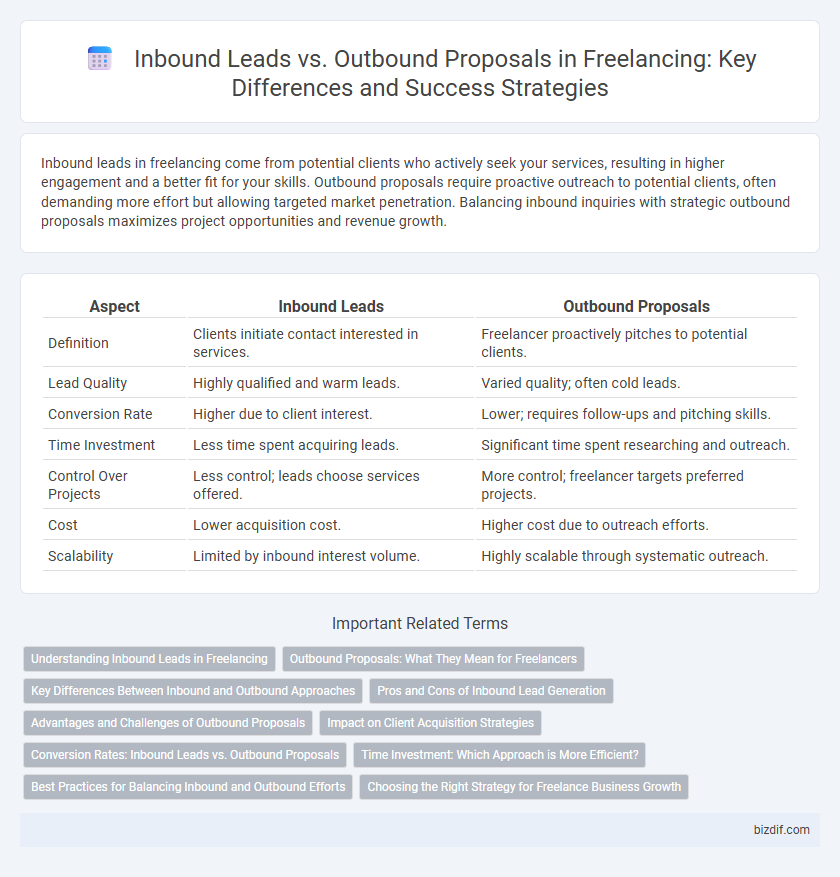Inbound leads in freelancing come from potential clients who actively seek your services, resulting in higher engagement and a better fit for your skills. Outbound proposals require proactive outreach to potential clients, often demanding more effort but allowing targeted market penetration. Balancing inbound inquiries with strategic outbound proposals maximizes project opportunities and revenue growth.
Table of Comparison
| Aspect | Inbound Leads | Outbound Proposals |
|---|---|---|
| Definition | Clients initiate contact interested in services. | Freelancer proactively pitches to potential clients. |
| Lead Quality | Highly qualified and warm leads. | Varied quality; often cold leads. |
| Conversion Rate | Higher due to client interest. | Lower; requires follow-ups and pitching skills. |
| Time Investment | Less time spent acquiring leads. | Significant time spent researching and outreach. |
| Control Over Projects | Less control; leads choose services offered. | More control; freelancer targets preferred projects. |
| Cost | Lower acquisition cost. | Higher cost due to outreach efforts. |
| Scalability | Limited by inbound interest volume. | Highly scalable through systematic outreach. |
Understanding Inbound Leads in Freelancing
Inbound leads in freelancing refer to potential clients who actively seek out your services, often triggered by your online presence, portfolio, or previous work reputation. These leads typically have a higher conversion rate because they originate from genuine interest rather than cold outreach. Leveraging inbound lead strategies such as SEO-optimized portfolios, client testimonials, and content marketing can significantly increase the quality and quantity of freelance projects.
Outbound Proposals: What They Mean for Freelancers
Outbound proposals represent proactive outreach where freelancers initiate contact with potential clients by submitting tailored project pitches. This strategy enhances visibility beyond passive waiting, allowing freelancers to target specific niches and projects aligned with their expertise. Crafting compelling outbound proposals increases the likelihood of securing high-quality projects and building long-term client relationships.
Key Differences Between Inbound and Outbound Approaches
Inbound leads in freelancing are generated when potential clients actively seek out services through organic methods like content marketing, referrals, and social media presence, resulting in higher trust and engagement rates. Outbound proposals involve freelancers proactively reaching out to prospects via cold emails, direct messages, or bidding platforms, which can increase outreach volume but often encounter lower response and conversion rates. The key difference lies in inbound capturing warm leads driven by client interest, while outbound relies on targeted prospecting to initiate contact and create new opportunities.
Pros and Cons of Inbound Lead Generation
Inbound lead generation attracts potential clients through content marketing, SEO, and social media, creating higher-quality leads who are already interested in your services. It requires less upfront effort compared to outbound proposals, reducing cold outreach and increasing conversion rates, but it depends heavily on consistent content creation and strong online presence. However, inbound leads may take longer to generate and can fluctuate based on market trends and search engine algorithms.
Advantages and Challenges of Outbound Proposals
Outbound proposals in freelancing offer direct control over client acquisition, allowing freelancers to target specific projects and industries that align with their skills. However, crafting personalized proposals requires significant time investment and may result in low response rates due to competition and client selectivity. Despite these challenges, outbound proposals can accelerate growth by actively reaching out to potential clients rather than waiting passively for inbound leads.
Impact on Client Acquisition Strategies
Inbound leads harness potential clients actively seeking services, boosting conversion rates by targeting users with existing interest. Outbound proposals require proactive outreach, expanding market reach but often yield lower response rates. Balancing inbound leads and outbound proposals enriches client acquisition strategies, optimizing resource allocation and maximizing engagement quality.
Conversion Rates: Inbound Leads vs. Outbound Proposals
Inbound leads typically yield higher conversion rates compared to outbound proposals due to pre-existing interest and relevance to the freelancer's services. Inbound leads often convert at rates between 20-50%, whereas outbound proposals generally show conversion rates ranging from 1-10%. Focusing on inbound lead generation strategies can significantly enhance overall project acquisition efficiency and return on investment for freelancers.
Time Investment: Which Approach is More Efficient?
Inbound leads typically require less time investment as clients initiate contact, allowing freelancers to focus on high-quality projects and reduce hours spent on prospecting. Outbound proposals demand significant effort in crafting personalized pitches and follow-ups, often leading to lower response rates and increased time expenditure. Efficient freelancers balance both approaches by leveraging inbound leads for steady work and selectively sending outbound proposals to target high-value opportunities.
Best Practices for Balancing Inbound and Outbound Efforts
Balancing inbound leads and outbound proposals requires strategic allocation of time and resources to maximize client acquisition. Prioritize inbound lead management by promptly responding to inquiries and nurturing relationships while maintaining a consistent outbound proposal schedule tailored to high-potential prospects. Leveraging CRM tools and data analytics enhances targeting accuracy and ensures efficient follow-up, optimizing overall freelancing growth.
Choosing the Right Strategy for Freelance Business Growth
Inbound leads generate higher-quality freelance projects by attracting clients actively seeking services, increasing conversion rates and fostering long-term relationships. Outbound proposals enable freelancers to proactively target niche markets and scale their client base through personalized outreach and consistent follow-ups. Analyzing project goals, market demand, and resource availability helps determine the optimal mix of inbound and outbound strategies for sustainable freelance business growth.
Inbound leads vs Outbound proposals Infographic

 bizdif.com
bizdif.com